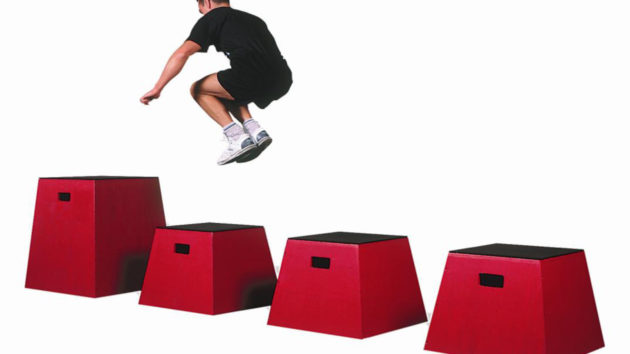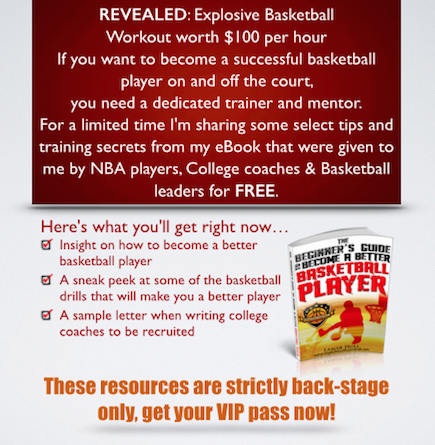
- 0
- 9.7K
- 0 likes
Basketball Plyometric Workout for Nasty Hops

Written By: Lamar Hull @ Google+
Plyometric Box Workouts For Basketball
Do you want some nasty hops so you can dunk?
Well, let me show you how if you put a little bit of effort and follow this simple week by week plyometric basketball box workout. First, let’s discuss the benefits of plyometrics!
Many basketball coaches, trainers, and players know the importance of plyometric workouts, as these exercises help improve lower body strength in a bid to help athletes jump higher.
Plyometrics mainly involves stretching muscles quickly and then contracting them just as fast to generate power. When this is done correctly, it can improve your vertical jump exponentially, on-court speed, strength and ability to decelerate if necessary.
Nevertheless, plyometric training for basketball should only be tailored to meet the specific needs of each individual basketball player. This is a workout that I used to do, so it may not necessarily fit your needs, but has some of the basic routines that will help increase your vertical.
In addition, always seek help from certified plyometric experts or trainers before embarking on these types of exercises for obvious health reasons.
I’m 5’9″ and I give plyometric training credit for my ability to hang on the rim with 2 hands off one leap and eventually dunk a basketball. Here is a entry level plyometric workout routine for basketball players to develop nasty hops on the court!
The First 2 Weeks
Start by doing ankle jumps using both legs to reduce stiffness. This will help you gain fast ankle action and ground grip. Then slowly advance to single-leg off-shoots after developing sufficient clout and coordination.
Perform ankle jumps for 2 weeks:
Both legs – 30 reps, 5 days (work on quickness)
*You obviously can add more reps to push yourself
At this stage, progress slowly to avoid unnecessary injuries. Follow up with repeated vertical jumps preferably with fast rebounds under the rim (30 reps, 5 days), then proceed by performing some front obstacle jumps involving raised hurdles or multiple cones (30 reps, 5 days).
Weeks 3 and 4
At this stage, you are allowed to bring more intensity when doing the plyo box workouts, a timetable can even be developed for more effectiveness.
Begin by getting in to a ready position with one cone in front of you. Routinely hop forward and backwards over that cone as fast as possible (work on quickness).
Repeat the process up to 30 times in a single session. This is known as a Linear Cone Jump and prepares you for other equally important steps mentioned below:
A) Standing Long Jump
Get in to an athletic stance, bend your hips and knees while sitting back in a quarter-squat position.
Rigorously swing your arms back and forth before simultaneously exploding with your legs forward, stretch as far wide as possible.
Land strongly with a stable base to absorb impact and allow the body to return back to its original starting position, then immediately repeated the procedure once again for around 15 reps.
This plyometric basketball exercise will help with increasing your explosion on the court and to the rim!
B) No-Arm Vertical Long Jump
Stand in a relaxed steady position with both hands behind your head, assume a quarter-squat stance like in the last plyometric drill and explode using legs only to jump as far out as possible.
Do this 15 times or as many as your body can tolerate. As you become better with time, feel free to incorporate more advanced basketball jumps and even weights if possible.
I would suggest incorporating more advanced plyometric drills when you fully understand the basic principles of plyo box exercises or you have a basketball trainer that knows what he or she is doing.
Note that each workout must preferably be done with maximum power, speed and quickness for you to develop nasty hops. If you cheat yourself, you are only making it harder for you to accomplish whatever goal you have set out for yourself when it comes to jumping.
Weeks 5 and 6
At this stage you’ll probably begin to experience some improvements in your jumping power, the only thing remaining is honing these skills and making them better.
The first training regime in week 5 is to skip jumps with a heel-to-toe push. Sit back on heels assuming a chair position with both arms stretched outwards in front of you.
Keenly move from side to side without directly affecting the upper body. Gain impetus to jump by commencing from the heels then driving through your toes.
This process should be repeated at least 15 times.
Squat Jumps
Stand on a level ground and then lower yourself to a squat position, forcefully stretch out the hips, ankles and knees before swinging your arms high up to jump as far out as possible.
Land gently then repeat the procedure once more for a specified number of reps. Swap it with Weight Squat Jumps for a more challenging plyometric basketball workout.
Later on try the Reactive Double-Leg Bounding, swing both arms forward and leap with maximum force. Land on soft knees and repeat everything once again, do this 15 times consecutively.
When performed correctly these plyometric basketball exercises will greatly improve your athletic ability.
Before commencing with any plyo box workouts, a preliminary warmup session would be necessary to calm down nerves and get the body prepared for what lies ahead.
The warmups should preferably advance from general routines like jogging or rope skipping, to more specific preparatory training regimes like dynamic body stretches that represent the exercises being done.
In general, the plyometric program stimulates basketball movements associated with speed, resistance and biomechanics which consequently leads to nasty hops.







LEAVE A COMMENT